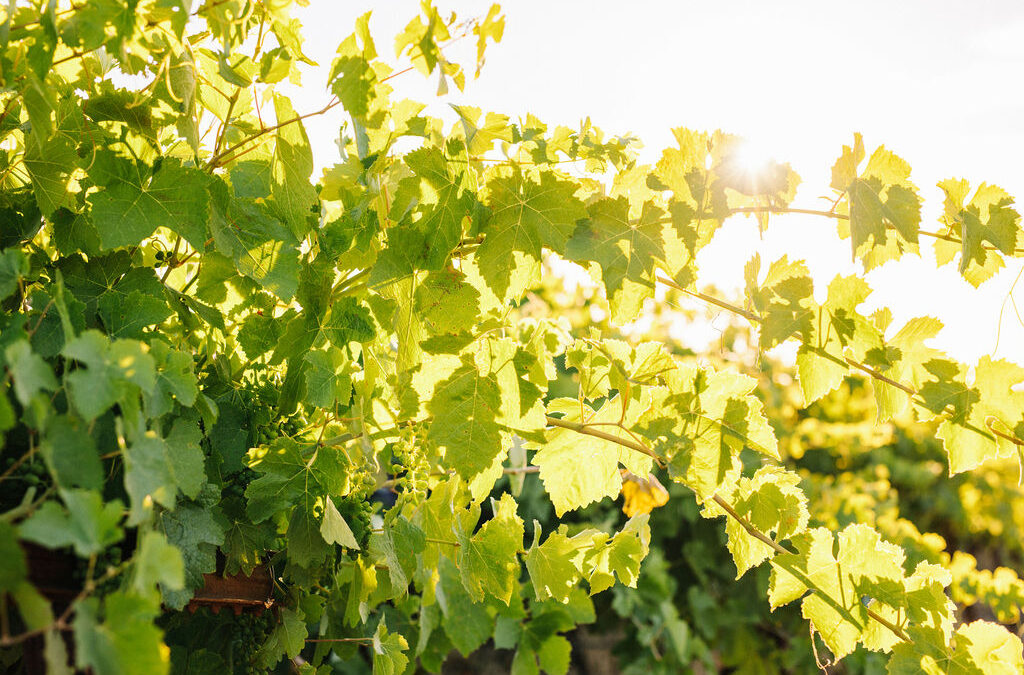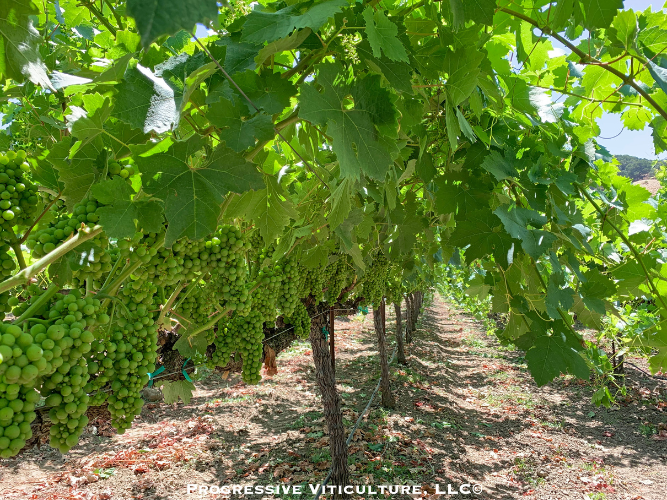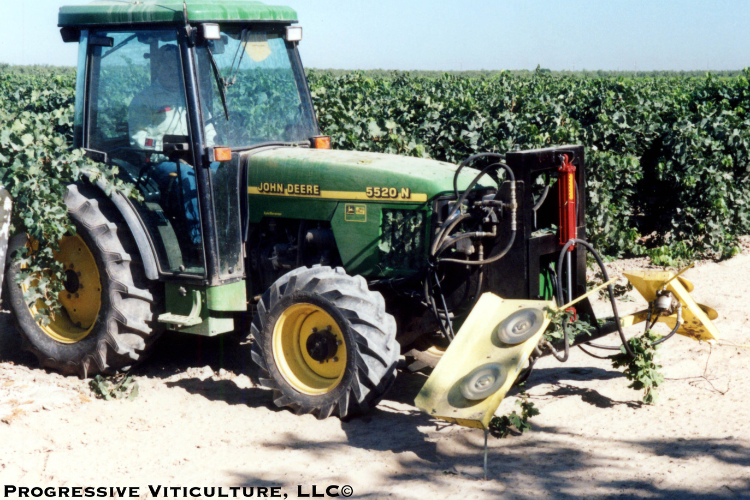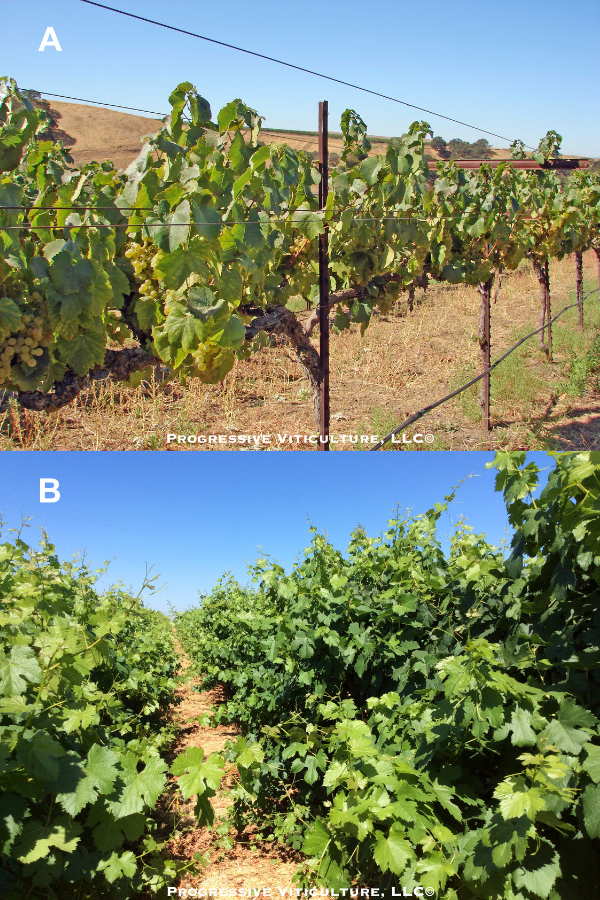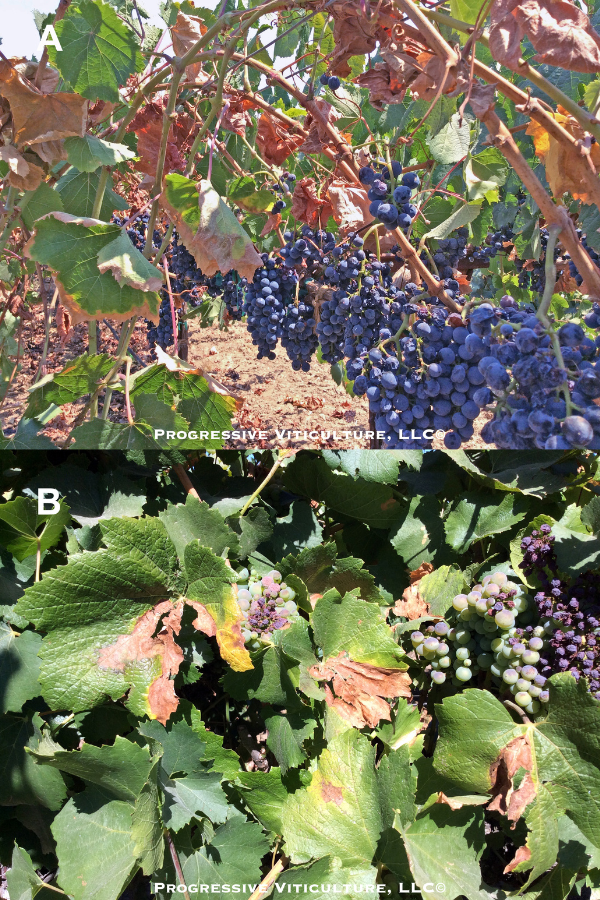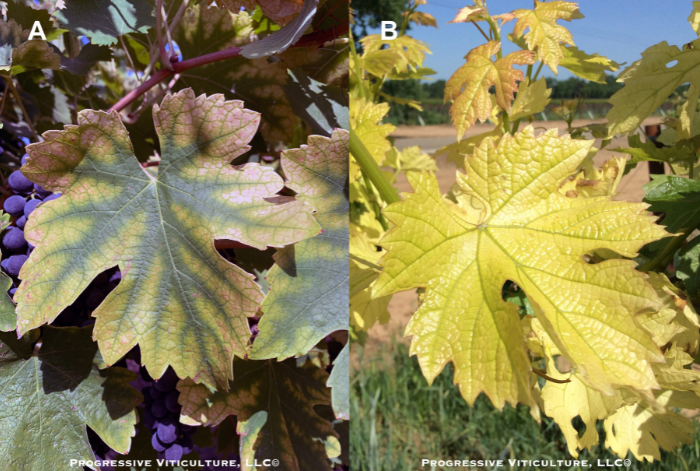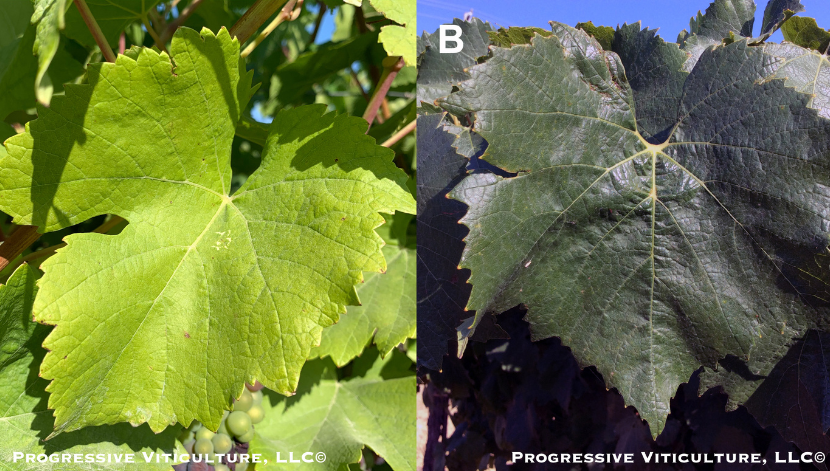MONDAY, JANUARY 1, 2024. BY STAN GRANT, VITICULTURIST.
Continued from GRAPEVINE CANOPY MANAGEMENT REVISITED PART 1
Direct Canopy Management – Configuration
Direct canopy management is canopy management by intervention. It takes two forms. The first, which is addressed here, involves either fine-tuning normal indirect canopy management effects or remediation of indirect canopy management miscalculations. Direct canopy management, in effect, sets the final physical configuration of the foliage in a vineyard. Canopy configuration practices include shoot thinning, fruit zone leaf removal, and shoot tipping or hedging (Figure 5).
Figure 5. Dappled sunlight at full canopy following shoot thinning and basal leaf removal of Zinfandel. (Photo Source: Progressive Viticulture, LLC©)
Shooting thinning to preserve or at least, approximate the shoot density set during pruning is an example of an intervention to fine-tune indirect canopy management. At the same time, retaining shoots arising from dormant buds on old wood to replace missing spurs and retaining shoots near the bottom of upward creeping arms to replace excessively high spurs are remedial actions. These shoot number adjustments are best made while shoots are short for expeditiousness and to conserve internal vine resources for the remaining shoots.
Even with careful pruning and shoot thinning, fruit zones of varieties with large leaves, such as Chardonnay and Malbec, usually require some leaf removal on the morning sun side of canopies to fine-tune cluster exposure to light and air movement. In some instances, the removal of lateral shoots within fruit zones achieves a similar result. Leaf removal is a remedial task where fruit zones are shaded due to shoot crowding. For maximum benefit and minimum risk of reduced yield and sun-damaged fruit, remove leaves shortly after fruit set.
Figure 6. Hedge canopies late and lightly to ensure adequate ripening capacity. (Photo Source: Progressive Viticulture, LLC©)
Hedging to improve the uniformity of canopy dimensions across a vineyard is a fine-tuning operation. In contrast, hedging is remedial where applied to impose growth balance in vineyards with excessive canopy growth. When employed, hedge as late and no more severely than necessary to minimize the loss of photosynthetic and ripening capacity (Figure 6).
Direct Canopy Management – Configuration for Extremes in Growth Vigor
In vineyards where vine growth vigor is very low and canopy development is incomplete, dramatic remediations are required (Figure 7A). In addition, to shoot thinning, cluster thinning before or shortly after fruit set is required to further reduce competition for limited internal vine resources. Also, eliminate weeds in vine rows and cover crops in tractor rows to minimize competition with vines for root zone resources. Simultaneously, increase the supply of external resources through liberal irrigation, soil amending, and fertilization to enhance root activity and stimulate shoot growth.
The reverse situation, with very high growth vigor, and excessive canopy development, requires measures beyond hedging (Figure 7B). Create a competition for soil resources with robust cover crops. At the same time, to the extent possible, limit water and nitrogen applications. For chronic cases, consider removing alternate vines within the vine rows (i.e., retrofit vine spacing) and extending the cordons of the remaining vines.
Figure 7. Chronic low growth vigor (A) and excessive growth vigor (B) require dramatic remediation. (Photo Source: Progressive Viticulture, LLC©)
Direct Canopy Management – Maintenance
Beyond directing shoot growth and configuring foliage there is a final aspect of canopy management. It is maintaining healthy leaves so canopies may remain adequately functional to achieve our goal of efficient production of economically viable yields of high-quality wine grapes over the long term. Naturally, many risks to leaf health emerge in vineyard environments over the course of a growing season.
Cordon and trunk diseases can compromise canopy size, root diseases can induce canopy collapse, and severe powdery mildew infections can cause premature leaf loss. Several damaging insect pests, including leafhoppers, leaffolders, and spider mites, can reduce leaf function and effective area. Fortunately, pests and diseases of grapevine canopies are controllable.
Even mild water stress impacts canopies, slowing shoot elongation and leaf expansion. Shoot growth and canopy development completely stop under moderate stress (leaf water potential of -10 to -12 bars). In well-designed and well-managed vineyards, such water stress occurs after canopies are fully developed. In other vineyards, canopies are either under or over-developed at the onset of moderate water stress, resulting in inefficient growth imbalances.
Figure 8. Severe water stress (A) and heat stress (B) leaf damage reduce the effective leaf area of canopies. (Photo Source: Progressive Viticulture, LLC©)
When water stress becomes severe (leaf water potential ≤ – 15 bars), photosynthesis is very slow or comes to a stop. With intensifying severe water stress, leaves wilt, thereby decreasing canopy leaf area and sunlight absorption capacity. The effects of prolonged severe water stress include the production and release of damaging active oxygen species within leaf cells and associated premature leaf tissue yellowing and death, causing an irreversible loss of canopy (Figure 8A).
During periods of triple-digit afternoon temperatures, sections of leaf tissue directly exposed to the sun can be damaged and die if not fully hydrated (Figure 8B). High levels of ultraviolet radiation can intensify the harmful effects of both heat stress and severe water stress on leaves and canopies. Clearly, careful regulation of the vineyard water supply and the mineral nutrients involved in vine water relations, especially potassium, is a critical element of direct canopy management.
Figure 9. Magnesium deficiency (A) and iron deficiency (B) diminish canopy functions. (Photo Source: Progressive Viticulture, LLC©)
In addition to restricting or altering shoot growth, foliar symptoms of most mineral nutrient deficiencies include specific patterns of leaf yellowing or reddening due to their impacts on photosynthesis or associated metabolism (Figure 9). At the other extreme of the mineral nutrient supply, certain excesses can become toxic, killing leaf tissues and decreasing production capacity. Accordingly, maintaining a balanced supply of mineral nutrients is essential for canopy health.
Among mineral nutrients, nitrogen may be most connected with grapevine canopies. Leaf chlorophyll concentration and photosynthetic rate are positively associated with vine nitrogen status (Figure 10), while at the same time, the vineyard nitrogen requirement to ensure adequate yeast assimilable nitrogen (YAN) for fermentation increases with canopy size. Importantly, excess nitrogen leads to excessive canopy growth and low production efficiency.
Figure 10. Leaf chlorophyll and photosynthetic capacity depend upon adequate nitrogen. (Photo Source: Progressive Viticulture, LLC©)
Canopy Management Measures of Success
As with all aspects of grape growing, we need some assurance our canopy management actions are effective. Perhaps the most obvious indicator is regularly achieving balanced growth, moderate water stress, and fruit exposure to dappled sunlight with minimum inputs shortly after the fruit set. Other measures of success involve controlled costs through operational efficiency, including limited need for canopy remediation, and low bunch rot incidence for disease-prone varieties. Consistent fruit yields and positive winery feedback regarding grape quality may be the most consequential indications of successful canopy management. A shortfall in any one of the measures of success ought to serve as a call for vineyard management self-evaluation.
Conclusions
Canopy management is the tending of grapevine foliage and the production machinery therein. It is a pivotal viticultural endeavor that has both short-term (current season) and long-term (vineyard longevity) impacts. Consistently successful canopy management involves setting and pursuing specific goals, optimizing indirect canopy management through a well-conceived vineyard design, fine-tuning through carefully applied direct canopy management practices, and assessing performance and identifying areas for improvement.
A version of this article was originally published in the Mid Valley Agricultural Services February 2006 newsletter and was updated for this blog post.
Further Reading
Archer, E and Strauss, HC. The effect of vine spacing on vegetative growth and reproductive performance of Vitis vinifera L. (cv Pinot Noir). S. Afr. J. Enol. Vitic. 1991.
Battany, M. Crop load, viruses, and potassium effects on canopy health. Grape Notes. UC Cooperative Extension, San Luis Obispo, and Sant Barbara counties. December 2005.
Bettiga, LJ (Ed.). Grape pest management. 3rd Ed. University of California Agricultural and Natural Resources, Oakland, CA. Publication 3343. pp.120-125. 2013.
Bledsoe, AM, Kliewer, WM, and Marois, JJ. Effects of timing and severity of leaf removal on yield and fruit composition of Sauvignon blanc. Am. J. Enol. Vitic. 39, 49-54. 1988.
Caccavello, G, Giaccone, M, Scogmamiglio, P, Mataffo, A, Teobaldelli, M, and Basile, B. Vegetative, yield, and berry quality response of Aglianico to shoot trimming applied at three stages of berry ripening. Am. J. Enol. Vitic. 70, 351-359. 2019.
Christensen, LP. Winegrape trellises for the San Joaquin Valley. Unpublished and undated report. Univ. Calif. Coop. Ext.
Christensen, LP. Winegrape canopy management practices in the San Joaquin Valley. American Vineyard Foundation Final Report. 1993.
Dokoozlian, NK, and Kliewer, WM. The light environment within grapevine canopies. I. Description and seasonal changes during fruit development. Am. J. Enol. Vitic. 46, 209-218. 1995a.
Dokoozlian, NK, and Kliewer, WM. The light environment within grapevine canopies. II. Influence of leaf density on fruit zone light environment and some canopy assessment parameters. Am. J. Enol. Vitic. 46, 209-226. 1995b.
Dokoozlian, N. Integrated canopy management: a twenty-year evolution in California. In Dokoozlian, N, and Wolpert, J (ed.). Recent advances in canopy management. Davis, California. July 16, 2009.
English, JT, Thomas, CS, Marois, JJ, and W. D. Gubler, WD. Microclimates of grapevine canopies associated with leaf removal and control of Botrytis bunch rot. Phytopathology. 79, 395-401. 1989.
English, JT, Bledsoe, AM, Marois, JJ, and Kliewer, WM. Influence of grapevine canopy management on evaporative potential in the fruit zone. Am. J. Enol. Vitic. 41, 137-141. 1990.
Freeman, BM, Tassie, E, and Rebbechi, MD. Training and trellising. pp. 42-65. In Coombe, B, and Dry, PR (ed.) Viticulture: Volume 2 Practices. Winetitles, Adelaide. 1992.
Galet, P. General Viticulture. Oenoplurimedia, Chaintre. 2000.
Geller, JP, and Kurtural, SK. Mechanical canopy and crop load management of Pinot gris in a warm climate. Am. J. Enol. Vitic. 64: 65-73. 2013.
Grant, S. Five-step irrigation schedule: promoting fruit quality and vine health. Practical Winery and Vineyard. 21(1): 46-52 and 75. May/June 2000.
Grant, S. Balanced soil fertility management in winegrape vineyards. Practical Winery and Vineyard. May/June 2002. 24 (1): 7-24.
Grant, S. The economics of vineyard design: trellising, vine spacing, and row spacing. January/February 2000. Practical Winery and Vineyard. 20(5): 48-63.
Grant, S. Vineyard management self-evaluation. Lodi Winegrape Commission Coffee Shop. (www.lodigrowers.com). November 18, 2013.
Grant, S. Regulated deficit irrigation, parts I and II. Lodi Winegrape Commission Coffee Shop. (www.lodigrowers.com) (www.lodigrowers.com). July 18 and August 4, 2014.
Grant, S. NRCS soil survey information important to vineyards. Lodi Winegrape Commission Coffee Shop. (www.lodigrowers.com). January 20, 2016.
Grant, S. Evaluating vineyard soils in trenches. Lodi Winegrape Commission Coffee Shop. (www.lodigrowers.com). February 17, 2016.
Grant, S. Comparative wine growing climatology. Lodi Winegrape Commission Coffee Shop. (www.lodigrowers.com). September 29, 2016.
Grant, S. Shoot thinning for multiple benefits. Lodi Winegrape Commission Coffee Shop. (www.lodigrowers.com). May 2, 2017.
Grant, S. To hedge or not to hedge? Lodi Winegrape Commission Coffee Shop. (www.lodigrowers.com). June 6, 2017.
Grant, S. Vineyard longevity. Lodi Winegrape Commission Coffee Shop. (www.lodigrowers.com). November 9, 2017.
Grant, S. Vineyard design and management for maximum efficiency. Lodi Winegrape Commission Coffee Shop. (www.lodigrowers.com). February 22, 2018.
Grant, S. Grapevine shoots and roots: the interconnectedness of the above and below ground grapevine. Wine Business Monthly. February 2019. pp. 148-152.
Grant, S. Vertical shoot positioned trellis systems in warm climates. Lodi Winegrape Commission Coffee Shop. (www.lodigrowers.com). May 06, 2019.
Grant, S. Vine growth capacity and horizontally divided vines. Lodi Winegrape Commission Coffee Shop. (www.lodigrowers.com). June 03, 2019.
Grant, S. Using competition to best advantage in vineyard management. Lodi Winegrape Commission Coffee Shop. (www.lodigrowers.com). June 8, 2020.
Grant, S. The seasonality of vineyard mineral nutrient management. Lodi Winegrape Commission Coffee Shop. (www.lodigrowers.com). May 24, 2021.
Grant, S. Mineral nutrient management methods. Wine Business Monthly. May 2022. pp. 44-49.
Gubler, W. D., J. J. Marois, A. M. Bledsoe, and L. J. Bettiga. Control of Botrytis bunch rot of grape with canopy management. Plant Dis. 71, 599-601.1987.
Gutierrez-Gamboa, G, Marin-san Roman, S, Jofre, V, Rubio-Breton, P, Perez-Alvarez, EP, and Garde-Cerdan, T. Effects on chlorophyll and carotenoid contents of different grape varieties (Vitis vinifera L.) after nitrogen and elicitor foliar applications to the vineyard. Food Chemistry. 269, 380-386. 2018.
Hedberg, PR, and Raison, J. The effect of vine spacing and trellising on yield and fruit quality of Shiraz grapevines. Am. J. Enol. Vitic. 33: 20-30. 1982.
Howell, GS. Sustainable grape productivity and the growth-yield relationship: a review. Am. J. Enol. Vitic. 53, 165-174. 2001.
Hunter, JJ, and Ruffner, HP. Diurnal and seasonal changes in nitrate reductase activity and nitrogen content of grapevines: effect of canopy management. Vitis. 36, 1-6. 1997.
Intrieri, C. Experiences on the effect of vine spacing and trellis-training system on canopy micro-climate, vine performance, and grape quality. Acta Hortic. 206: 69-87. 1987.
Intrieri, C, Poni, S, Rebucci, B, and Magnini, E. Effects of canopy management on whole-vine photosynthesis; results from pot and field experiments. Vitis. 36, 167-173. 1997.
Intrieri, C, and Filippetti, I. Planting density and physiological balance: comparing approaches to European viticulture in the 21st century. pp. 296-308. In Proceedings of the ASEV 50th anniversary annual meeting. Seattle. June 19-23, 2000.
Jackson, D. Pruning and training. (Monographs in cool climate viticulture-1). Lincoln University Press, Canterbury, NZ. 1997.
Jackson, DI, and Lombard, PB. Environmental and management practices affecting grape composition and wine quality – A review. Am. J. Enol. Vitic. 44, 409-430. 1993.
Jensen, F, Andris, H, Beebe, B, and Bettiga, L. The effects of row spacing, variety, and trellis on yields of three wine varieties. Unpublished report. Univ. Calif. Coop. Ext.
Keller, M. Deficit irrigation and mineral nutrition. Proceedings of the Soil Environment and Mineral Nutrition Symposium. Christensen, LP, Smart, DR (ed.). Amer. Soc. Enol. Vitic. pp. 267-283. 2005.
Keller, M. The science of grapevines. Academic Press, Burlington, MA. 2010.
Kliewer, W. M. and R. E. Smart. Canopy manipulation for optimizing vine microclimate, crop yield, and composition of grapes. In: Manipulations of Fruiting. C. J. Wright (Ed). pp. 275-290. Butterworths, London. 1989.
Kliewer, WM, and Casteel, T. Canopy management. In Hellman, EW (ed). Oregon viticulture. Oregon State University Press, Corvallis. pp.177-184. 2003.
Matthews, MA. Terroir and other myths. University of California Press. Oakland. 2015.
Mullins, MG, Bouquet, A., and Williams, LE. Biology of the grapevine. Cambridge University Press, Cambridge. 1992.
Myers, JK, Wolpert, JA, and Howell, GS. Effect of shoot number on the leaf area and crop weight relationship of young Sangiovese grapevines. Am. J. Enol. Vitic. 59, 422-424. 2008.
Reynolds, AG, and Wardle, DA. Impacts of various canopy manipulation techniques on growth, yield, fruit composition, and wine quality of Gewurztraminer. Am. J. Enol. Vitic. 40, 121-129. 1989.
Reynolds, AG, Wardle, DA, and Dever, M. Shoot density effects on Riesling grapevines: interactions with cordon age. Am. J. Enol. Vitic. 457, 435-443. 1994.
Reynolds, AG, Wardle, DA, and Naylor, AP. Impact of training system, vine spacing, and basal leaf removal on Riesling. Vine performance, berry composition, canopy microclimate, and vineyard labor requirements. Am. J. Enol. Vitic. 47: 63-76. 1996.
Reynolds, AG. Impact of trellis/training systems and cultural practices on production efficiency, fruit composition, and vine balance. In: JM Rantz (ed). Proc. ASEV 50th Anniversary Meeting. Seattle, WA. pp. 309-317. 2000.
Schubert, A, Restagno, M, Novello, V, and Peterlunger, E. Effects of shoot orientation on growth, net photosynthesis, and hydraulic conductivity of Vitis vinifera L. cv. Cortese. Am J. Enol. Vitic. 46, 324-328. 1995.
Shaulis, N, Amberg, H, and Crowe, D. Response of Concord grapes to light exposure and Geneva double curtain training. Proc. Amer. Soc. Hort. Sci. 89: 268-80. 1966.
Shaulis, NJ. Responses of grapevines and grapes to spacing of and within canopies. In A. Webb (ed).Grapes and Wine Centennial Symposium Proceedings. Davis, Calif. Univ. Calif. 80. 1982.
Shultz, HR. Photosynthesis of sun and shade leaves of field-grown grapevines (Vitis vinifera L.) in relation to leaf age. Suitability of the plastochron concept for the expression of physiological age. Vitis. 32, 197-205. 1993.
Shultz, HR. Grape canopy structure, light microclimate, and photosynthesis. I. A two-dimensional model of the spatial distribution of surface area densities and leaf ages in two canopies. Vitis. 34, 211-215. 1995.
Smart, RE. Principles of grapevine canopy management microclimate manipulation with implications for yield and quality. A review. Am. J. Enol. Vitic. 36, 230-239. 1985.
Smart, RE. Shoot spacing and canopy light microclimate. Am. J. Enol. Vitic. 39, 325-333. 1988.
Smart, RE. Canopy management. In: Coombe, B; Dry, PR (ed). Viticulture: Volume 2 Practices. Winetitles, Adelaide. pp 85-103. 1992.
Smart, R, and Robinson, M. Sunlight into wine: A Handbook for Winegrape Canopy Management. Winetitles, Adelaide. 1991.
Stapleton, J. J. and R. S. Grant. Leaf removal for nonchemical control of summer bunch rot complex of winegrapes in the San Joaquin Valley. Plant Dis. 76, 205-208. 1992.
Steel, M, Gitelson, AA, and Rundquist, D. Nondestructive estimation of leaf chlorophyll content in grapes. Am. J. Enol. Vitic. 59, 299- 305. 2008.
Terry, DB, and Kurtural, SK. Achieving vine balance of Syrah with mechanical canopy management and regulated deficit irrigation. Am. J. Enol. Vitic. 62: 426-437. 2011.
Tommaso, F, Acimovic, D, VanderWeide, J, Tombesi, S, Palliotti, A, Gatti, M, Poni, S, and Sabbatini, P. Whole-canopy source-sink balance at bloom dictates fruit set in cv. Pinot noir subjected to early leaf removal. Am. J. Enol. Vitic. 70, 411-419. 2019.
Verdenal, T, Zufferey, V, Huberty, M, Melot, C, Dienes-Nagy, A, and Spring, J-L. Leaf area management affects grape nitrogen content. IVES Technical Reviews. October 2021. https://ives-technicalreviews.eu/article/view/4852.
Velez, S, Poblete-Echeverria, C, Rubio, JA, Vacas, R, and Barajas, E. Estimation of leaf area index in vineyards by analyzing projected shadows using UAV imagery. OENO One. 159-180. 2021.
Weaver, RJ, and Kasimatis, AN. Effect of trellis height on with and without cross-arms on yield of Thompson Seedless grapes. Journal of the American Society for Horticultural Science. 100, 252-253. 1975.
Weaver, RJ, Kasimatis, AN, Johnson, JO, and Vilas, N. Effect of trellis height and cross-arm width and angle on yield of Thompson Seedless grapes. American Journal of Enology and Viticulture. 35, 94-96. 1984.
Wang, X, De Bei, R, Fuentes, S, and Collins, C. Influence of canopy management practices on canopy architecture and reproductive performance of Semillon and Shiraz grapevines in a hot climate. Am. J. Enol. Vitic. 70, 306-372. 2019.
Westwood, MN. Temperate-zone pomology: physiology and culture. Timber Press. Portland. pp 523. 1993.
Winkler, AJ, Cook, JA, Kliewer, WM, and Lider, LA. General Viticulture. University of California, Berkeley. 1974.
Zufferey, V, Mursier, F, and Shultz, HR. A model analysis of the photosynthetic response of Vitis vinifera L. cvs Riesling and Chasselas leaves in the field. I. Interaction of age, light, and temperature. Vitis. 39, 19-26. 2000.
Have something interesting to say? Consider writing a guest blog article!
To subscribe to the Coffee Shop Blog, send an email to stephanie@lodiwine.com with the subject “blog subscribe.”
To join the Lodi Growers email list, send an email to stephanie@lodiwine.com with the subject “grower email subscribe.”
To receive Lodi Grower news and event promotions by mail, send your contact information to stephanie@lodiwine.com or call 209.367.4727.
For more information on the wines of Lodi, visit the Lodi Winegrape Commission’s consumer website, lodiwine.com.
For more information on the LODI RULES Sustainable Winegrowing Program, visit lodigrowers.com/standards or lodirules.org.

